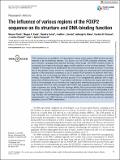The influence of various regions of the FOXP2 sequence on its structure and DNA binding function
Abstract
FOX proteins are a superfamily of transcription factors which share a DNA-binding domain referred to as the forkhead domain. Our focus is on the FOXP subfamily members, which are involved in language and cognition amongst other things. The FOXP proteins contain a conserved zinc finger and a leucine zipper motif in addition to the forkhead domain. The remainder of the sequence is predicted to be unstructured and includes an acidic C-terminal tail. In the present study, we aim to investigate how both the structured and unstructured regions of the sequence cooperate so as to enable FOXP proteins to perform their function. We do this by studying the effect of these regions on both oligomerisation and DNA binding. Structurally, the FOXP proteins appear to be comparatively globular with a high proportion of helical structure. The proteins multimerise via the leucine zipper, and the stability of the multimers is controlled by the unstructured interlinking sequence including the acid rich tail. FOXP2 is more compact than FOXP1, has a greater propensity to form higher order oligomers, and binds DNA with stronger affinity. We conclude that while the forkhead domain is necessary for DNA binding, the affinity of the binding event is attributable to the leucine zipper, and the unstructured regions play a significant role in the specificity of binding. The acid rich tail forms specific contacts with the forkhead domain which may influence oligomerisation and DNA binding, and therefore the acid rich tail may play an important regulatory role in FOXP transcription.
Citation
Thulo , M , Rabie , M A , Pahad , N , Donald , H L , Blane , A A , Perumal , C M , Penedo , C & Fanucchi , S 2021 , ' The influence of various regions of the FOXP2 sequence on its structure and DNA binding function ' , Bioscience Reports , vol. 41 , no. 1 , BSR20202128 . https://doi.org/10.1042/BSR20202128
Publication
Bioscience Reports
Status
Peer reviewed
ISSN
0144-8463Type
Journal article
Description
Funding: University of the Witwatersrand, South African National Research Foundation Grant 80681 to S.F., Grant 68898 to H.W.D., the South African Research Chairs Initiative of the Department of Science and Technology and National Research Foundation Grant 64788 to H.W.D., the Medical Research Council of South Africa and the Royal Society Grant NAF/R2/180787 to SF.Collections
Items in the St Andrews Research Repository are protected by copyright, with all rights reserved, unless otherwise indicated.

